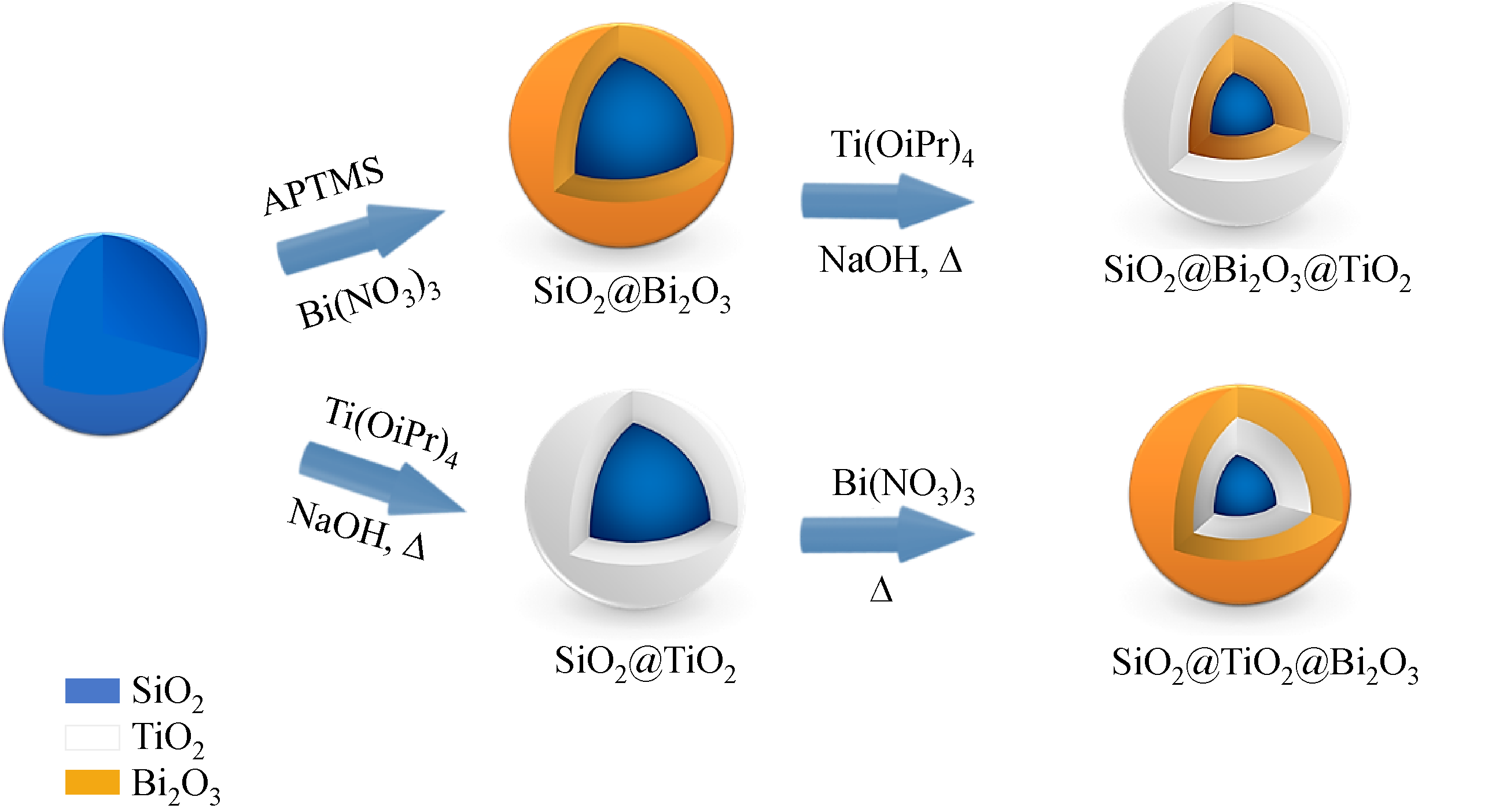

Interfacial charge transfer and photocatalytic activity in a reverse designed Bi2O3/TiO2 core-shell
Received date: 30 Jan 2021
Accepted date: 29 Apr 2021
Published date: 15 Sep 2021
Copyright
In this study, the electronic and photocatalytic properties of core-shell heterojunctions photocatalysts with reversible configuration of TiO2 and Bi2O3 layers were studied. The core-shell nanostructure, obtained by efficient control of the sol-gel polymerization and impregnation method of variable precursors of semiconductors, makes it possible to study selectively the role of the interfacial charge transfer in each configuration. The morphological, optical, and chemical composition of the core-shell nanostructures were characterized by high-resolution transmission electron microscopy, UV-visible spectroscopy and X-ray photoelectron spectroscopy. The results show the formation of homogenous TiO2 anatase and Bi2O3 layers with a thickness of around 10 and 8 nm, respectively. The interfacial charge carrier dynamic was tracked using time resolved microwave conductivity and transition photocurrent density. The charge transfer, their density, and lifetime were found to rely on the layout layers in the core-shell nanostructure. In optimal core-shell design, Bi2O3 collects holes from TiO2, leaving electrons free to react and increase by 5 times the photocatalytic efficiency toward H2 generation. This study provides new insight into the importance of the design and elaboration of optimal heterojunction based on the photocatalyst system to improve the photocatalytic activity.

Key words: photocatalysis; core-shell; heterojunction; H2; TiO2; Bi2O3
Sabina Ait ABDELKADER , Zhenpeng CUI , Abdelghani LAACHACHI , Christophe COLBEAU-JUSTIN , Mohamed Nawfal GHAZZAL . Interfacial charge transfer and photocatalytic activity in a reverse designed Bi2O3/TiO2 core-shell[J]. Frontiers in Energy, 2021 , 15(3) : 732 -743 . DOI: 10.1007/s11708-021-0772-x
| 1 |
Kumaravel V, Mathew S, Bartlett J,
|
| 2 |
Reza Gholipour M, Dinh C T, Béland F,
|
| 3 |
Ghazzal N M, Chaoui N, Aubry E,
|
| 4 |
Gesesse G D, Wang C, Chang B K,
|
| 5 |
Gesesse G D, Le Neel T, Cui Z,
|
| 6 |
Liu M, Inde R, Nishikawa M,
|
| 7 |
Liu G, Du K, Haussener S,
|
| 8 |
Naldoni A, Altomare M, Zoppellaro G,
|
| 9 |
Moniz S J A, Shevlin S A, Martin D J,
|
| 10 |
Yi S, Zhang X, Wulan B,
|
| 11 |
Wang C, Li J, Paineau E, Laachachi A,
|
| 12 |
Wei L, Yu C, Zhang Q,
|
| 13 |
Li J, Jiménez-Calvo P, Paineau E,
|
| 14 |
Bessekhouad Y, Chaoui N, Trzpit M,
|
| 15 |
Xu D, Hai Y, Zhang X,
|
| 16 |
Lopes O F, Carvalho K T G, Avansi W Jr,
|
| 17 |
Wu Y, Lu G, Li S. The doping effect of Bi on TiO2 for photocatalytic hydrogen generation and photodecolorization of rhodamine B. Journal of Physical Chemistry C, 2009, 113(22): 9950–9955
|
| 18 |
Zhang L, Ye X, Boloor M,
|
| 19 |
Xie M, Fu X, Jing L,
|
| 20 |
Ho C H, Chan C H, Huang Y,
|
| 21 |
Bessekhouad Y, Robert D, Weber J V. Photocatalytic activity of Cu2O/TiO2, Bi2O3/TiO2 and ZnMn2O4/TiO2 heterojunctions. Catalysis Today, 2005, 101(3–4): 315–321
|
| 22 |
Ayekoe P Y, Robert D, Goné D L. Preparation of effective TiO2/Bi2O3 photocatalysts for water treatment. Environmental Chemistry Letters, 2016, 14(3): 387–393
|
| 23 |
Reddy N L, Emin S, Valant M,
|
| 24 |
Meng S, Sun W, Zhang S,
|
| 25 |
Gesesse G D, Li C, Paineau E,
|
| 26 |
Chen M, Li Y, Wang Z,
|
| 27 |
Ghazzal M N, Kebaili H, Joseph M,
|
| 28 |
Ghazzal M N, Wojcieszak R, Raj G,
|
| 29 |
Sanna S, Esposito V, Andreasen J W,
|
| 30 |
Jiang H Y, Cheng K, Lin J. Crystalline metallic Au nanoparticle-loaded α-Bi2O3 microrods for improved photocatalysis. Physical Chemistry Chemical Physics, 2012, 14(35): 12114–12121
|
| 31 |
Ghazzal M N, Chaoui N, Genet M,
|
| 32 |
Nam H J, Amemiya T, Murabayashi M,
|
| 33 |
Xu Y, Schoonen M A A. The absolute energy positions of conduction and valence bands of selected semiconducting minerals. American Mineralogist, 2000, 85(3–4): 543–556
|
| 34 |
Savenije T J, Ferguson A J, Kopidakis N,
|
/
| 〈 |
|
〉 |